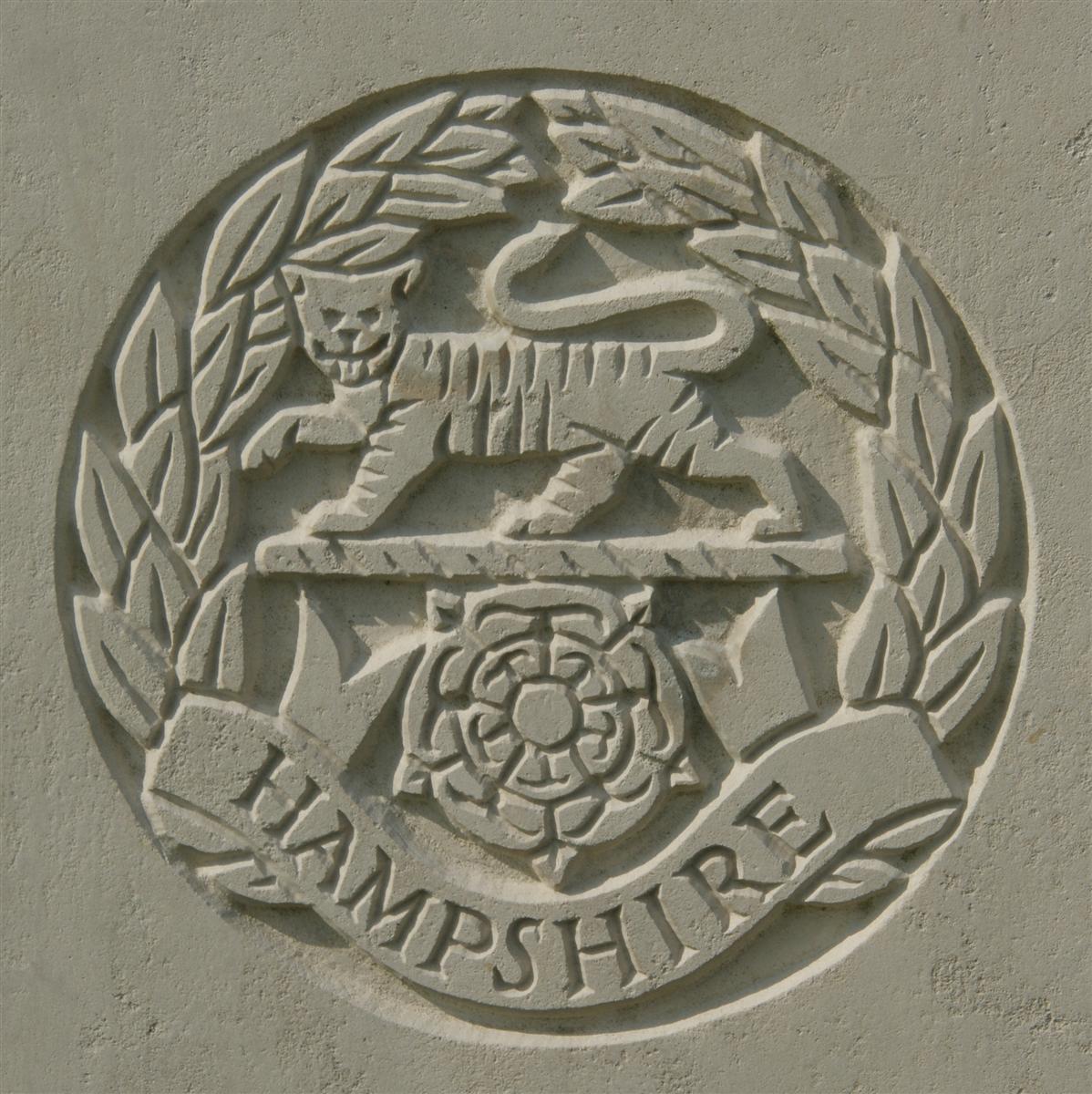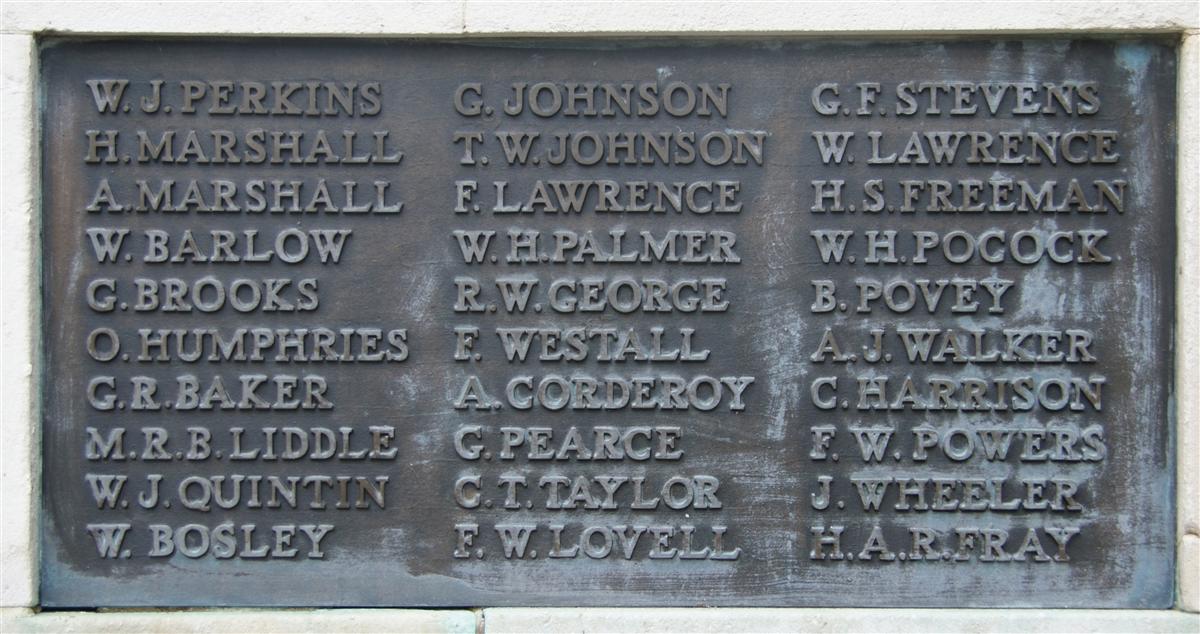Albert Corderoy
Private 26964 Albert Corderoy, 15th (Service) Battalion, Hampshire Regiment
Albert was born in Newbury in 1897, the youngest son of Albert and Anne Corderoy née Wernham. Their other known children were Sarah Annie (born 1881), Henry (Harry) Charles (1883), Rose (1886), Elizabeth (1888), Maud (1891), Beatrice May (1894), Kate (1899) and Ethel (1902). Anne did give birth to five more children, all of whom died in infancy.
Albert senior worked in the building trade as scaffolder or general labourer and raised his family in a small cottage at 6 Mayor’s Lane. Albert junior did not follow his father’s trade, instead going to work for a local baker, Mr Rogers, where he was learning the baking trade when war was declared in August 1914. Along with hundreds of thousands of other young men Albert signed up for service in the Army, in his case he opted to serve in the Hampshire Regiment, perhaps because a friend or relative was already serving in the regiment.

The regimental badge of the Hampshire Regiment, as used on CWGC headstones. |
This huge influx of volunteers became known as Kitchener’s Army after the Secretary of War, Lord Kitchener, who appealed for 100,000 young men to come forward and serve their country – only to find almost 1,000,000 signing up by Christmas. The battalions raised from these volunteers were officially designated as ‘service’ battalions – reflecting the terms of their enlistment ‘for the duration of the war’, unlike regular soldiers who signed up for fixed terms, usually of 12 years. Albert was posted to the 15th (Service) Battalion of the Hampshire Regiment, which was formed in Portsmouth in April 1915. In October 1915 it moved to Aldershot and became a part of the 122nd Infantry Brigade in 41st Division. The Division crossed to France in May 1916, during the build up to the Battle of the Somme, where most of Kitchener’s Army was to see its first major action.
The Division was involved in the later stages of the Somme and was then moved north into the Ypres Salient where it was to see more action during the 3rd Battle of Ypres, better known as Passchendaele.
On 20 October 1917 the British launched the third phase of the 3rd Battle of Ypres, an action known as the Battle of the Menin Road. The aim was to capture German positions along the Menin Road Ridge to the east of Ypres (Ieper). The 15th Hampshires were in the thick of it from day one, as their war diary clearly illustrates:
War Diary, 15th (Service) Battalion, Hampshire Regiment
20/9/1917 5.40am was Zero hour for an attack which was made by the 122nd Inf Brigade with TOWER TRENCH East of GHELEVULT as its final objective.
The attack was made on a two Battalion front, each Batt on a two Company front and was organized in depth.
The Order of Battle was :- 15th Batt HANTS REGT on the left, 18th KRRC on the right, who were allotted the task of taking the first & second objectives. The RED and BLUE Line (west & east of BASSEVILLEBEKE respectively) after which the 11th WEST KENTS on the left and 12th E SURREYS on the right were to pass through and assault the final objective, the GREEEN LONE (TOWER TRENCH).
The Assembly took place without great difficulty and the attack was launched at 5.40am.
The 15 Hants were checked by a strong point which had been untouched by the barrage about 5 minutes after the start, which was soon overcome by the gallantry of Officers and men in storming the position. After this the BLUE LINE which was the 15 Hants objective was reached without difficulty. Casualties were heavy including all four Company Commanders. A counter attack was threatened from NE (on the MENIN ROAD) but was dispersed by rifle & machine gun fire. The 11th WEST KENTS passed through us but failed to take their objective owing to strong resistance from the neighbourhood of TOWER HAMLETS and fell back on to the BLUE LINE.
At 5.30 orders were received to the effect that two Battalions of 122nd Infantry Brigade (the 15th Hants & 11th West Kents) were to attack the GREEN LINE.
The 11th WEST KENTS were too disorganized at the time so that the attack was carried out by 130 men of the 15th HANTS.
The position was captured and over 40 prisoners, a Battalion Commander and his Adjutant, two Machine Guns and one Field Gun were taken. The objective was consolidated and held against several counter attacks in spite of the fact that the 123rd Brigade, who attacked three times on our right, failed to reach their objective.
21/9/17 At about 10am 2/Lt M S Moore, who was in command of the GREEN LINE slightly withdrew his men to avoid our own barrage, which was being fired at GREEN LINE through false information. After this, he returned to his position in Green line.
3.35pm Battalion observers reported enemy massing to counter attack in the valley SE and the SOS was sent up. The enemy, however, were repulsed by rifle and machine gun fire before our Artillery had opened. Liquid fire containers were seen on the backs of some of the enemy, one of which was seen to burst into flames.
3.45pm & 6.30pm The GREEN LINE was then barraged by the enemy and again shortly afterwards heavily bombarded by our own Artillery, who thought the position abandoned.
Weather fine
Albert fell in action at some point in the first day of this action:
Newbury Weekly News, 25 October 1917 – Local War Notes
The parents of Private Albert Corderoy, of the Hants Regiment, who live in Mayor’s Lane, have received the sad tidings that he was killed on September 20th last. He was hit by a shell while leaving the trenches, and his death was instantaneous. He had been in the Army since the beginning of the war, and had been in France a year and eight months. Before this he was employed as a baker by Mr Rogers, and his loss will be regretted by many friends.
Albert’s body was never identified, his name is recorded on the Tyne Cot Memorial a short distance from the village of Passchendaele.

Albert's name on Newbury War Memorial (bottom left) |
The war took a great toll on the Corderoy family, as well as the loss
of Albert; three of his sisters lost their husbands. Sarah Annie’s husband, James Grigg, was too old for frontline service but did his bit guarding POWs until he was invalided out of the Army with the illness that killed him a few months later. Beatrice May married George Wootten, who died serving in the Royal Berkshire Regiment at the Battle of Cambrai.
Maud married William Sims, a hairdresser, in 1914 at
Kingston-on-Thames; William (Private, 1st/7th Battalion, Royal
Warwickshire Regiment) died of wounds in Italy on 23 September 1918,
as he was never a Newbury resident he was not put forward for
commemoration on the Newbury memorial.
Thanks to Albert’s great-great nephew, Steve Miller, for his invaluable contributions to this story and to Karen Newbury for her help in the original research into this soldier.

